Exploring The Solent Shore - Lepe Beach
By Mike on Saturday, June 14, 2014, 20:49 - Permalink
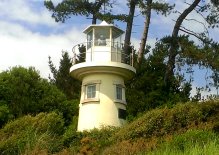 On a baking hot, humid spring day, we visited Lepe Beach for a picnic lunch and a walk along the shore.
On a baking hot, humid spring day, we visited Lepe Beach for a picnic lunch and a walk along the shore.
The Route
We started from the main car park, walking west to a point a little beyond Lepe House, back along the same route and out again to the east along the shore, then inland a little and back through the meadow. Not a very long walk, but it was a very hot and airless day and we had no energy to go any further.
Setting Off
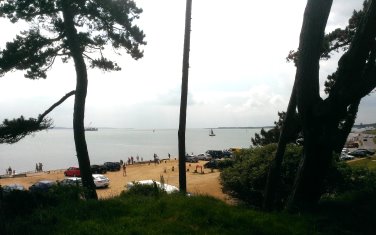 We arrived a little after midday, so the first stop was actually a stroll up the hill behind the car park to a small grassy plateau where we sat and ate our picnic.
We arrived a little after midday, so the first stop was actually a stroll up the hill behind the car park to a small grassy plateau where we sat and ate our picnic.
This area has a small playground for children and is visited by ice cream vans - so it's very family-friendly. From here. you can also get a good view of the ships and boats out in the Solent - and on a clear day, the Isle of Wight seems a mere stone's throw away, although it's actually a couple of miles.
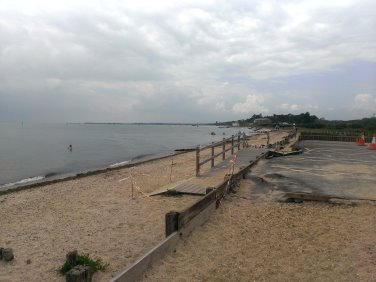 We set off from the car park along the beach and seafront to the west - it was high tide when we arrived, so there wasn't actually a lot of beach.
We set off from the car park along the beach and seafront to the west - it was high tide when we arrived, so there wasn't actually a lot of beach.
The beach here is a little more sandy than some others in the Solent - making it quite popular with sunbathers and swimmers.
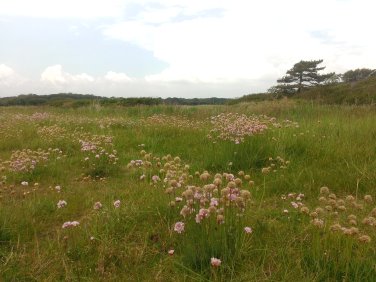 To the north, behind the coast road, there is a significant area of wild wetlands - an important area for wildlife - particularly migrating birds.
To the north, behind the coast road, there is a significant area of wild wetlands - an important area for wildlife - particularly migrating birds.
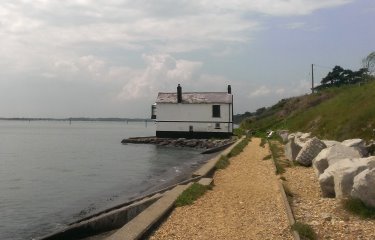 About half a mile along the shore, there's a little white house - once presumably either a boathouse or possibly lifeboat station, but now a private dwelling. Lovely location, but built very low to the water - I wonder what it must be like there during a storm.
About half a mile along the shore, there's a little white house - once presumably either a boathouse or possibly lifeboat station, but now a private dwelling. Lovely location, but built very low to the water - I wonder what it must be like there during a storm.
 A little further along is a tiny Lighthouse, which looks quaint and old, but is in fact quite modern - the Millennium Beacon (built in 2000) - this lighthouse helps boats navigate into the mouth of the Beaulieu river - which is obscured by a long, narrow gravel spit that protrudes a mile or so east from the west bank of the river mouth.
A little further along is a tiny Lighthouse, which looks quaint and old, but is in fact quite modern - the Millennium Beacon (built in 2000) - this lighthouse helps boats navigate into the mouth of the Beaulieu river - which is obscured by a long, narrow gravel spit that protrudes a mile or so east from the west bank of the river mouth.
The spit actually looks like it might be really interesting - so I'll explore it in a future addition to this series.
 Past the lighthouse, the shore has suffered considerable erosion, despite the network of wooden posts that has been driven into the ground to try to halt it.
Past the lighthouse, the shore has suffered considerable erosion, despite the network of wooden posts that has been driven into the ground to try to halt it.
 Lepe House, formerly an 18th Century inn called The Ship Inn, was enlarged into a country house.
Lepe House, formerly an 18th Century inn called The Ship Inn, was enlarged into a country house.
In 1943, Lepe House was requisitioned by the Royal Navy and served as a base for the D Day landings. Remnants of some of the shoreline reinforcements and structures apparently still remain on the beach - I shall have to return sometime at low tide to take a look.
A little way past Lepe House, we had to stop and turn around - as some sort of engineering project was underway, blocking the path (this would probably not have been an obstacle at lower tides.
The structure out in the water is, I believe, a dredging vessel or platform.
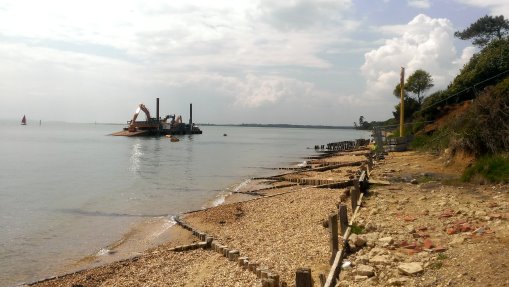
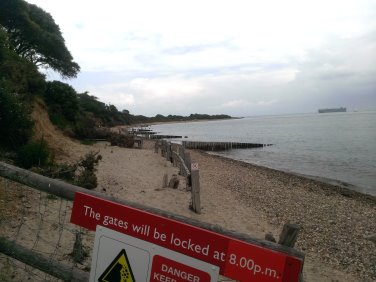 We walked back to the car park, then set off in the opposite direction - toward Calshot.
We walked back to the car park, then set off in the opposite direction - toward Calshot.
Signs are posted here warning about possible danger from collapsing cliffs - and there is evidence of erosion here, however, the cliffs are only a few metres tall and are easily avoided, so the risk is minimal.
The beach here is a little broader and flatter - and probably good for beachcombing for shells and fossils.
after about half a mile or so, the cliff drops and becomes a sort of grassy bank. There's more beach to be walked here, but this is the point where we turned back.
There is again here an area of marshy wetland that I'm sure is very valuable to wildlife.
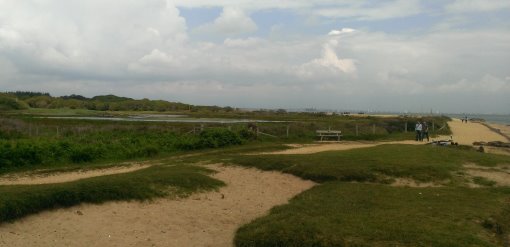

Turning inland and back toward the car park, there is a broad swathe of grassy meadow, hedges and scrub - displaying a great abundance of wild flowers and absolutely buzzing with insects.
Again, this is no doubt a hugely valuable resource for birds, needing to refuel before or after migration - rich habitats like this usually also support small rodents, reptiles and amphibians, which in turn will be exploited by birds of prey and other predators such as foxes and stoats.
 There's ample space in amongst this peaceful grassland for visitors to throw down a picnic rug and enjoy the peaceful location (take your litter home with you).
There's ample space in amongst this peaceful grassland for visitors to throw down a picnic rug and enjoy the peaceful location (take your litter home with you).
But there are also some gems here not to be trampled - such as these orchids (common spotted, I think).
That was the end of our brief exploration of Lepe Beach - this isn't a part of the Solent that I frequently visit (as it's on the other side of Southampton Water from me), but I sense there's a lot more here I still need to see.
Carpobrotus Edulis
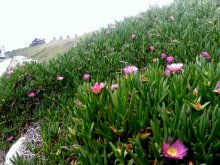 We found some well-developed patches of Carpobrotus edulis here - a mediterranean succulent plant also known as Hottentot Fig (I've written about this before when I encountered it in Spain)
We found some well-developed patches of Carpobrotus edulis here - a mediterranean succulent plant also known as Hottentot Fig (I've written about this before when I encountered it in Spain)
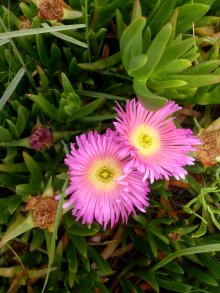 This plant supposedly produces edible fruit - I've never yet been in the right place at the right time to try them, and it's most often written up as not being capable of producing mature fruit in the UK...
This plant supposedly produces edible fruit - I've never yet been in the right place at the right time to try them, and it's most often written up as not being capable of producing mature fruit in the UK...
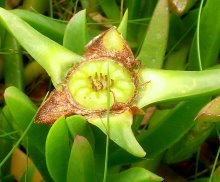 However, at the time we visited, there were some quite well-developed fruits on the plants - already having shed their petals and fattened up.
However, at the time we visited, there were some quite well-developed fruits on the plants - already having shed their petals and fattened up.
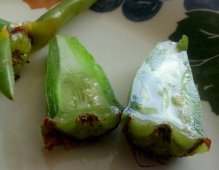 I picked a couple and took them home for examination - sliced open, they seemed to be quite well-filled, and the juicy contents were very sticky, which I took to mean that they are starting to fill up with sugars.
I picked a couple and took them home for examination - sliced open, they seemed to be quite well-filled, and the juicy contents were very sticky, which I took to mean that they are starting to fill up with sugars.
They had almost no flavour at this stage though, however, I feel quite confident that these might ripen properly in the few months of hopefully warm weather we have ahead of us this summer. Maybe I'll go back and sample them again later.
